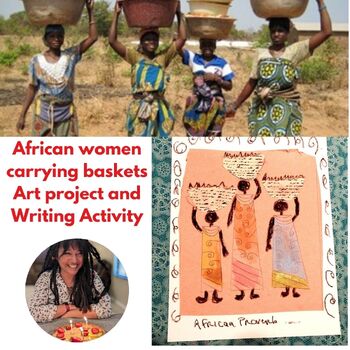African Women Art Lesson K-4th Why African Women Carry Baskets on Their Heads
- PDF
Also included in
- Africa 5 Art Lesson Bundle K-5th Grade Geography Lesson Passport IdeaThese lessons are perfect to enhance your cultural studies in a general education classroom setting or your Montessori or homeschool setting. Each lesson offers a brief lesson on the culture and origin of the art your students crePrice $11.00Original Price $15.99Save $4.99
Description
In this lesson, your students will discover why African women carry baskets on their heads and explore the significance of this tradition through a guided art project. This lesson is perfect for elementary students, specifically 1st, 2nd and 3rd graders.
This lesson will guide your students through the history of African women and the role of basket-carrying in their culture. They will learn about the materials used to create these baskets and their functional and cultural significance.
After learning about the history, your students will then create their own drawing of women carrying baskets on their heads, incorporating various art techniques and elements such as line, shape, and color.
Here are four ways to incorporate this lesson into your elementary classroom:
- Cultural Studies: This lesson is a perfect opportunity to teach your students about the diversity of African cultures and the ways in which traditions are passed down through generations.
- Art History: Your students will gain an appreciation for the rich artistic history of African women and the significance of the basket-carrying tradition.
- Art Techniques: Through this lesson, your students will learn about different art techniques and elements of design, such as line, shape, and color.
- Empathy and Understanding: Through learning about African women and their traditions, your students will develop empathy and understanding for cultures different from their own.
What teachers are saying:
- Thanks so much! I love the lesson piece on the baskets and the finished product looks fabulous on our art wall!
- perfect for my insecure artists
What you will find inside the lesson:
- Teacher prompts for you to read as you give the lesson making it EASY to teach!
- Brief discussion of each topic that is simple and easy to comprehend
- Questions to ask the students about the art
- Step by step DETAILED instructions for an art project with FULL COLOR pictures.
- INSTRUCTIONS ON HOW TO CONFORM THIS LESSON TO COMMON CORE STANDARDS
- Art work to show as examples
- Comprehension questions Worksheet for you to extend the learning that feature key facts about each art project
- Word search and coloring page for fast finishers
- Worksheet where students have the opportunity to give you feedback about the projects
Make sure to click the GREEN STAR near my store name so that you can stay in touch with my store. I create new lessons every week.






